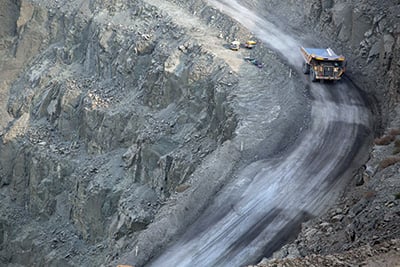How much high-risk adventure in foreign lands are mining clients willing to take, and has their appetite for it changed in recent years? The answer may vary case by case, but caution is definitely the watchword: “We have clients who are definitely refocussing on less politically volatile settings and now only consider opportunities in riskier geographies when they directly complement current holdings. While other clients are maintaining projects in riskier areas and have not exited, these projects are largely being kept on hold,” says Goodmans LLP partner Catherine Lyons.
In an issue of Insights into Mining, KPMG LLP identified its Top 10 risks facing Canadian mining and metal companies in 2018. They are:
1. Commodity price risk
2. Permitting risk
3. Access to capital, including liquidity
4. Community relations and social license to operate
5. Controlling capital costs
6. Environmental risk
7. Political risk
8. Ability to access and replace reserves
9. Controlling operating costs
10. Capital allocation
Since 2016 at least, “community relations and social license to operate” has ranked fourth, while “political risk” has continued at seventh. In other words, these are important risks, considered by mining clients after financial risks, particularly this year. And the top three on the 2018 list returned in the same order from last year. As Bradley Berg and John Wilkin of Blake, Cassels & Graydon LLP put it, “Commodity prices continue to be a significant factor for investment decisions. Financing projects in challenging regions, however, remains a challenge.”
We are not trying to create a trend then, where one does not exist. However, it is difficult to unpack the size of the risk when, along with standing on its own, it accelerates other risks. Leading Lexpert-ranked lawyers are observing their clients acting on community license and political risk.
Lyons says, “Based on the chatter we’ve heard, and from some of the deals I’ve seen over the past few years, yes, companies are looking to de-risk and de-lever. This has resulted in selling off non-core projects or those in less than stable jurisdictions. Many have had to write down the projects already, so that provides some flexibility to sell (maybe taking equity to try and capture some upside when things turn around). Another impact is a rush to quality jurisdictions. For example, we’ve seen activity in the cobalt sector in Canada which has been fuelled by a desire to avoid the need to get cobalt from other less stable parts of the world.”
In the spring of 2018, Reuters reported on the volatility in the cobalt market. In an article entitled “Battery makers descend on Australia, Canada cobalt developers,” Melanie Burton and Nicole Mordant wrote:
“Nervous Asian battery makers are turning to early-stage cobalt projects in Australia and Canada to lock in supplies of the critical battery ingredient ahead of expected shortages as demand for electric vehicles revs up. Mine developers say interest from Japanese and Korean firms is particularly strong as they compete with rivals from China, which has built deep supply chain ties with the Democratic Republic of Congo, the world’s top producer.”
The DRC “accounts for nearly two-thirds of global cobalt output and production is set to rise despite concerns over the use of child miners and rising royalties.”
More particularly, “With over 85% of new global cobalt supply over the next decade coming from Africa, in a region where the Chinese have entrenched relationships, the Korean and Japanese cobalt processing industries are very focused upon Australian and Canadian projects.”
Burton and Mordant provide examples:
“South Korean battery maker SK Innovation Co Ltd (096770.KS) locked in a seven-year supply deal with Australian Mines (AUZ.AX) last month, helping to win funding for a project that has yet to make a final investment decision and does not expect to produce any cobalt until at least 2020.
“‘At least half a dozen Australian and Canadian mine developers are currently in talks on potential supply deals with battery and automakers for production at some point beyond late 2019-2021,’ company executives told Reuters.
“These include Australia’s Aeon Metals (AML.AX), Northern Cobalt (N27.AX) and Cobalt Blue, and Canada’s Ecobalt (ECS.TO) and Fortune Minerals (FT.TO). China’s Beijing Easpring Material Technology Co (300073.SZ), which makes products for battery makers, has also signed a binding five-year deal with Australian mine developer Clean Teq (CLQ.AX).
“‘We are speaking to a number of parties about the balance of the offtake — that includes not just Chinese potential customers but also customers from other parts of the world,’ Clean Teq’s CEO Sam Riggall told Reuters.
“In an indication of heightened demand, Riggall said automotive companies were also showing interest, along with cathode manufacturers, the direct users of cobalt, a key material in lithium-ion batteries.
“In the DRC, production is set to rise sharply, driven by commodity giant Glencore Plc (GLEN.L), the world’s biggest producer, and Luxembourg’s ERG taking DRC’s share of global output to over 75% by 2023, according to UK-based Darton Commodities.
“Glencore last week agreed to sell around a third of its cobalt production over the next three years to Chinese battery recycler GEM Co Ltd (002340.SZ). Developments in Australia and Canada will be small to mid-size, producing around 1,000 to 5,000 tonnes each, in a global market expected to swell to some 157,000 tonnes by 2023.”
The main producing country of cobalt, DRC, has deeply entrenched social problems that the global public, especially those who would drive electric cars, will protest with their wallets and social media activity.
“Certainly some of the groups that we have spoken to have said that they won’t look at DRC sources, they want clean ethical sources of cobalt,” said Matthew Painter, Ardea’s General Manager, Gold to Reuters.
Cobalt is but one example of the oft-mentioned reality that national governments are not the only drivers of political or community risk for mining companies – or crucially, for investors. The demand for change can come from dedicated activists and grassroots movements. Ultimately, they can have an impact on commodity prices and access to capital.
High-performance companies are even looking beyond the need for cobalt. Japan’s Panasonic (6752.T), the main battery supplier to Tesla, Inc. (TSLA.O), said it was aware of issues in the DRC and was looking to source some material elsewhere, and it was also looking at lowering its dependency on cobalt.
Stikeman Elliott LLP’s Jay Kellerman has seen movement before: “Over the course of a 30-year career, I have watched capital move around the globe — from Kilometre 88 in Venezuela, to Chile and Argentina, to Russia and the FSU, then China, over to Australia, across to Africa, being South Africa and West Africa and now more and more back to North America. And this will continue depending on opportunity, economics and politics.
“We have clients who stick to Canada (and even provinces within Canada) and we have clients who would rather work in the DRC than South Africa. It is all over the map quite literally which makes this industry such an exciting and dynamic industry. Wherever a company works though, whether here in Canada or abroad, from my perspective, it is all about the quality of the asset and opportunity and earning and maintaining your social license in the broadest sense.”
Berg and Wilkin, like Kellerman, attest to the focus their clients apply to each project. “We do see clients continuing to invest in projects in higher risk locations, but with their eyes wide open. Mining companies and their boards remain quite cautious, exercising increasingly greater due diligence and training.
“Clients are focused on securing a strong social license in these jurisdictions, and ensuring policies and procedures are in place to manage anti-corruption and similar issues. We are seeing mining companies with management teams that have strong in-country or regional experience find opportunities to leverage that knowledge and skill set, and have been able acquire quality mineral projects in these more challenging jurisdictions.”
Canadian law firms have ramped up their capacity to assist their clients with assessing and responding to political and community risks.
“Commodity price risk is once again the leading challenge facing mining executives as they consider the downside of the recent upswing in prices,” says Heather Cheeseman, GTA Mining Leader and Partner, Audit and Risk Consulting, KPMG in Canada. “With volatility making a comeback, mining businesses must plan for the future as they optimize scarce resources, flatten the cost curve, sharpen their focus on corporate social responsibility and mitigate political risk in key jurisdictions.”
In an issue of Insights into Mining, KPMG LLP identified its Top 10 risks facing Canadian mining and metal companies in 2018. They are:
1. Commodity price risk
2. Permitting risk
3. Access to capital, including liquidity
4. Community relations and social license to operate
5. Controlling capital costs
6. Environmental risk
7. Political risk
8. Ability to access and replace reserves
9. Controlling operating costs
10. Capital allocation
Since 2016 at least, “community relations and social license to operate” has ranked fourth, while “political risk” has continued at seventh. In other words, these are important risks, considered by mining clients after financial risks, particularly this year. And the top three on the 2018 list returned in the same order from last year. As Bradley Berg and John Wilkin of Blake, Cassels & Graydon LLP put it, “Commodity prices continue to be a significant factor for investment decisions. Financing projects in challenging regions, however, remains a challenge.”
We are not trying to create a trend then, where one does not exist. However, it is difficult to unpack the size of the risk when, along with standing on its own, it accelerates other risks. Leading Lexpert-ranked lawyers are observing their clients acting on community license and political risk.
Lyons says, “Based on the chatter we’ve heard, and from some of the deals I’ve seen over the past few years, yes, companies are looking to de-risk and de-lever. This has resulted in selling off non-core projects or those in less than stable jurisdictions. Many have had to write down the projects already, so that provides some flexibility to sell (maybe taking equity to try and capture some upside when things turn around). Another impact is a rush to quality jurisdictions. For example, we’ve seen activity in the cobalt sector in Canada which has been fuelled by a desire to avoid the need to get cobalt from other less stable parts of the world.”
In the spring of 2018, Reuters reported on the volatility in the cobalt market. In an article entitled “Battery makers descend on Australia, Canada cobalt developers,” Melanie Burton and Nicole Mordant wrote:
“Nervous Asian battery makers are turning to early-stage cobalt projects in Australia and Canada to lock in supplies of the critical battery ingredient ahead of expected shortages as demand for electric vehicles revs up. Mine developers say interest from Japanese and Korean firms is particularly strong as they compete with rivals from China, which has built deep supply chain ties with the Democratic Republic of Congo, the world’s top producer.”
The DRC “accounts for nearly two-thirds of global cobalt output and production is set to rise despite concerns over the use of child miners and rising royalties.”
More particularly, “With over 85% of new global cobalt supply over the next decade coming from Africa, in a region where the Chinese have entrenched relationships, the Korean and Japanese cobalt processing industries are very focused upon Australian and Canadian projects.”
Burton and Mordant provide examples:
“South Korean battery maker SK Innovation Co Ltd (096770.KS) locked in a seven-year supply deal with Australian Mines (AUZ.AX) last month, helping to win funding for a project that has yet to make a final investment decision and does not expect to produce any cobalt until at least 2020.
“‘At least half a dozen Australian and Canadian mine developers are currently in talks on potential supply deals with battery and automakers for production at some point beyond late 2019-2021,’ company executives told Reuters.
“These include Australia’s Aeon Metals (AML.AX), Northern Cobalt (N27.AX) and Cobalt Blue, and Canada’s Ecobalt (ECS.TO) and Fortune Minerals (FT.TO). China’s Beijing Easpring Material Technology Co (300073.SZ), which makes products for battery makers, has also signed a binding five-year deal with Australian mine developer Clean Teq (CLQ.AX).
“‘We are speaking to a number of parties about the balance of the offtake — that includes not just Chinese potential customers but also customers from other parts of the world,’ Clean Teq’s CEO Sam Riggall told Reuters.
“In an indication of heightened demand, Riggall said automotive companies were also showing interest, along with cathode manufacturers, the direct users of cobalt, a key material in lithium-ion batteries.
“In the DRC, production is set to rise sharply, driven by commodity giant Glencore Plc (GLEN.L), the world’s biggest producer, and Luxembourg’s ERG taking DRC’s share of global output to over 75% by 2023, according to UK-based Darton Commodities.
“Glencore last week agreed to sell around a third of its cobalt production over the next three years to Chinese battery recycler GEM Co Ltd (002340.SZ). Developments in Australia and Canada will be small to mid-size, producing around 1,000 to 5,000 tonnes each, in a global market expected to swell to some 157,000 tonnes by 2023.”
The main producing country of cobalt, DRC, has deeply entrenched social problems that the global public, especially those who would drive electric cars, will protest with their wallets and social media activity.
“Certainly some of the groups that we have spoken to have said that they won’t look at DRC sources, they want clean ethical sources of cobalt,” said Matthew Painter, Ardea’s General Manager, Gold to Reuters.
Cobalt is but one example of the oft-mentioned reality that national governments are not the only drivers of political or community risk for mining companies – or crucially, for investors. The demand for change can come from dedicated activists and grassroots movements. Ultimately, they can have an impact on commodity prices and access to capital.
High-performance companies are even looking beyond the need for cobalt. Japan’s Panasonic (6752.T), the main battery supplier to Tesla, Inc. (TSLA.O), said it was aware of issues in the DRC and was looking to source some material elsewhere, and it was also looking at lowering its dependency on cobalt.
Stikeman Elliott LLP’s Jay Kellerman has seen movement before: “Over the course of a 30-year career, I have watched capital move around the globe — from Kilometre 88 in Venezuela, to Chile and Argentina, to Russia and the FSU, then China, over to Australia, across to Africa, being South Africa and West Africa and now more and more back to North America. And this will continue depending on opportunity, economics and politics.
“We have clients who stick to Canada (and even provinces within Canada) and we have clients who would rather work in the DRC than South Africa. It is all over the map quite literally which makes this industry such an exciting and dynamic industry. Wherever a company works though, whether here in Canada or abroad, from my perspective, it is all about the quality of the asset and opportunity and earning and maintaining your social license in the broadest sense.”
Berg and Wilkin, like Kellerman, attest to the focus their clients apply to each project. “We do see clients continuing to invest in projects in higher risk locations, but with their eyes wide open. Mining companies and their boards remain quite cautious, exercising increasingly greater due diligence and training.
“Clients are focused on securing a strong social license in these jurisdictions, and ensuring policies and procedures are in place to manage anti-corruption and similar issues. We are seeing mining companies with management teams that have strong in-country or regional experience find opportunities to leverage that knowledge and skill set, and have been able acquire quality mineral projects in these more challenging jurisdictions.”
Canadian law firms have ramped up their capacity to assist their clients with assessing and responding to political and community risks.
“Commodity price risk is once again the leading challenge facing mining executives as they consider the downside of the recent upswing in prices,” says Heather Cheeseman, GTA Mining Leader and Partner, Audit and Risk Consulting, KPMG in Canada. “With volatility making a comeback, mining businesses must plan for the future as they optimize scarce resources, flatten the cost curve, sharpen their focus on corporate social responsibility and mitigate political risk in key jurisdictions.”





